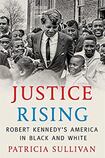
Patricia Sullivan’s brilliant and beautifully written biography of Robert Kennedy could hardly be more timely. Focusing on Kennedy’s engagement with the African American freedom struggle, it arrives in the wake of Black Lives Matter protests that demanded renewed public attention to institutional racism in the US and elsewhere. A privileged white man who came to embrace the cause of racial justice as his own, Kennedy offers a model of how to be an anti-racist ally.
Though Justice Rising is highly sympathetic to Kennedy, it hardly reduces the civil rights struggle to the actions of heroic white men. In fact, it shows that Kennedy addressed racism only because the issue was forced upon him by a mass social movement.
Justice Rising opens with a revealing anecdote. In May 1963, with the civil rights movement at high pitch and Kennedy in the thick of it as US attorney general, he agreed to meet leading African American intellectuals in New York City. A group including the novelist James Baldwin, the singer Harry Belafonte, the actor Lena Horne and the playwright Lorraine Hansberry visited Kennedy at his family’s apartment overlooking Central Park.
Kennedy expected to be thanked for the actions he and his brother had taken on civil rights. Instead, for over three hours the group insisted that they had done far too little. At the meeting was Jerome Smith, a young civil rights activist who was in New York getting treatment for the serious head wounds he incurred while agitating for equality. Smith was a visible illustration of the violence against African Americans embedded in American society that Kennedy, as the nation’s leading law enforcer, had not done enough to prevent.
Achieving equal rights in law, Kennedy heard, would only go so far toward achieving equality. The legislation the Kennedys had drafted (which eventually became the Civil Rights Act of 1964) did little to tackle the poverty, police brutality and housing discrimination faced by African Americans outside the Jim Crow South. Nor did it address the anger created by systemic racism. Baldwin warned Kennedy that many urban African Americans were at breaking point. Indeed, the first of a series of urban African American uprisings occurred in 1964 in Harlem after an off-duty policeman murdered a 15-year-old African American.
Justice Rising shows that Kennedy would never have faced up to racial injustice had African Americans not demanded he do so. Yet it also demonstrates that Kennedy was a remarkable figure whose character combined relentless energy with an extraordinary empathy for others and a willingness to learn from experience. At the 1963 meeting, Kennedy was annoyed at the lack of gratitude shown for his efforts. But he stayed, he listened and he learned.
Kennedy’s empathy for those less fortunate than himself partly derived from his upbringing. Despite his elite background, Kennedy grew up feeling like a misfit within his own family and the elite and Protestant-dominated schools he attended. Boundless energy and optimism was seemingly a Kennedy family trait: once he came to see racism as a problem, he worked tirelessly to address it.
Kennedy met the challenge posed by the civil rights movement not with defensiveness, hostility or indifference but with a willingness to learn from and identify with those oppressed by racism
Kennedy’s education on racism and his efforts to combat it began in earnest with his appointment as attorney general in 1961. In 1960, Kennedy had engineered the support of southern segregationists for his brother’s presidential campaign. But as attorney general, he got a quick course in how white southerners enforced Jim Crow segregation with extra-legal violence. In response, Kennedy transformed the justice department’s civil rights division into an effective institution for pushing school desegregation and enforcing black voting rights. He did so despite resistance from J Edgar Hoover, the powerful FBI director who opposed the civil rights movement and portrayed it as a communist plot. Hoover was behind Kennedy’s biggest misstep on racial justice when he convinced him to authorise the wiretapping of Martin Luther King’s phone.
After John F Kennedy’s assassination, Robert Kennedy successfully ran for the US Senate in New York; his national stature was second only to that of president Lyndon Johnson. In forging his own political career, Kennedy foregrounded racism, which he now grasped was something more deeply rooted than southern segregation. He made racial inequality a central issue of his 1968 campaign for the Democratic presidential nomination, which ended tragically with his assassination.
It is tempting to imagine Kennedy living a long life and charting an alternate path in American history to the mass incarceration and over-policing of African Americans that sparked the Black Lives Matter movement. But it is impossible to know how things might have been different and foolish to think that any one man could have rectified a problem so deeply seated.
What we do know is that Kennedy left a legacy of how a white person can fight racism. Kennedy met the challenge posed by the civil rights movement not with defensiveness, hostility or indifference but with a willingness to learn from and identify with those oppressed by racism. His example remains relevant today not only in the US but also globally including in this country to which he traced his roots.
Daniel Geary is an associate professor in American history at Trinity College Dublin
















